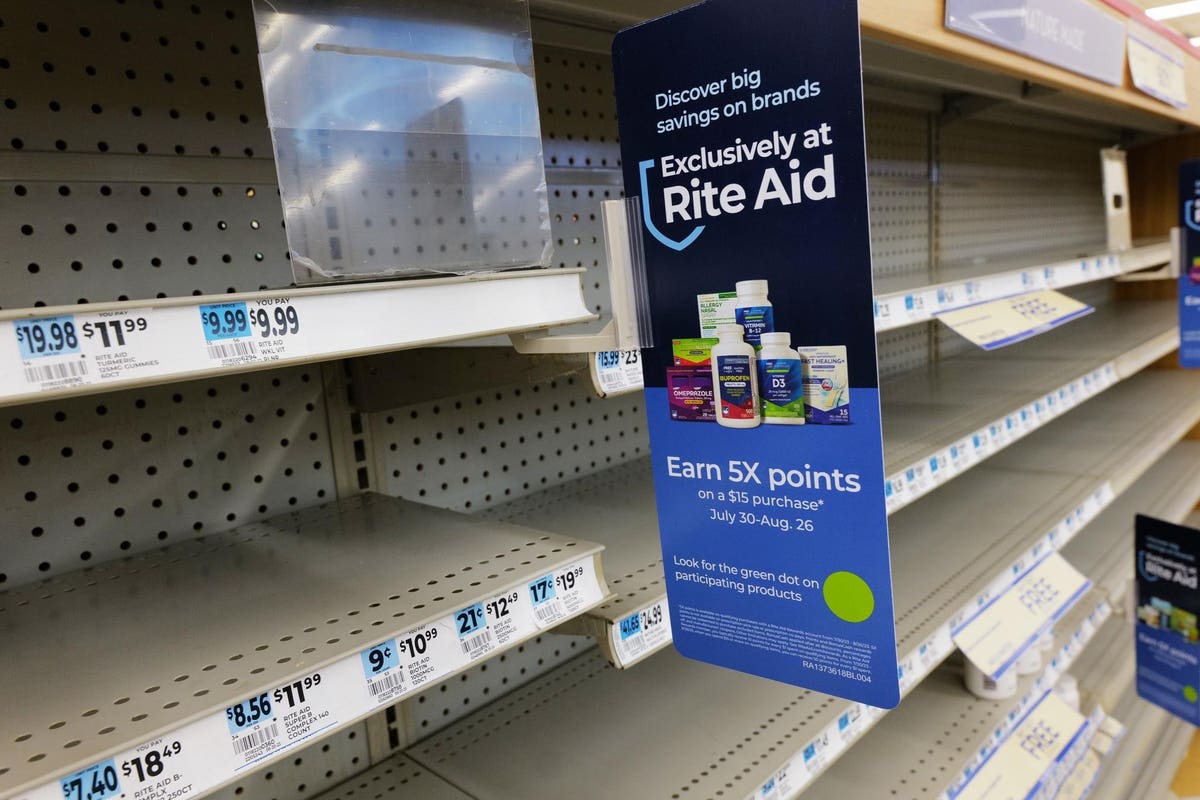The nation’s largest drugstore chains are facing mounting pressure, and they’ve prescribed the same script to cure their ills: closing stores.
Already drowning in $3.3 billion in debt and facing pending opioid-related lawsuit settlements, Rite Aid, the nation’s number three pharmacy chain behind CVS and Walgreens, is preparing for bankruptcy.
As part of ongoing negotiations, it proposes to close 400 to 500 of its 2,100 stores, though its bondholders want even more to shutter. Its retail pharmacy segment generated $17.8 billion last year and $288 million in adjusted EBITDA.
Earlier this year, number two CVS completed a strategic review and announced plans to shutter 900 stores between 2022 and 2024. It’s already pulled the plug on 300 of them.
GlobalData analyst Neil Saunders shared with CNN that too many of its stores have fallen into disrepair, with “bad lighting, depressing interiors, messy merchandising and a weak assortment of products. They are not destinations or places where people go out of anything other than necessity.”
CVS retail brought in $106.6 billion in revenues last year and operated nearly 8,000 stores plus some 2,000 pharmacies in retail chains, including Target
TGT
Then there is number one Walgreens, with its U.S. pharmacy segment, including Duane Reade, operating just shy of 9,000 stores and generating $109.1 billion in sales. It announced plans to close 150 locations in a cost-saving move. And it also reduced the operating hours in some 1,100 stores.
Economic headwinds for its customers are turning against the company. “Our customer is feeling the strain of higher inflation and interest rates, lower SNAP benefits and tax refunds, and an uncertain economic outlook,” said CEO Rosalind Brewer in the latest earnings call.
All three drug chains have different reasons for closing stores, but the downsizing prescription is the same. Chain drugstores cost a lot to operate, and they don’t have sufficient differentiation to attract customers feeling the economic pinch.
TheStreet columnist Thomas Lee warned, “Closing stores is a fact of life for retailers. But some closings should worry consumers and investors more than others,” referencing Walgreens specifically, but it applies to all in the sector.
“As a pharmacy chain, Walgreens primarily sells the stuff that people depend on for daily life, the merchandise that is supposedly more immune to inflation. Because of the worsening economy, the rest of the industry should take note,” he continued.
Same Stuff Sold The Same Way
Let’s face it: unless one notices the nameplate on the door, little distinguishes shopping in one major drugstore from another. They sell much the same stuff in pretty much the same way.
They’ve tried to differentiate with additional product offerings, such as adding upscale beauty lines, but that only puts them into greater competition with Ulta and Sephora, which hold the distinction of being many consumers’ primary beauty destinations.
They’ve got greeting cards, but so does Hallmark and Walmart
WMT
As chain stores diversified, they’ve sent mixed messages to consumers that jeopardize their position as the consumers’ health and wellness partner. This has created a foothold for independent pharmacies that make being a drugstore their number one priority.
A study by the Pharmaceutical Care Management Association found that the number of independent pharmacies grew 13% from 2010 to 2019, up from 20,427 to 23,061, while the number of chain pharmacies remained stable at about 39,000.
Clearly, the shop-local movement enhances the appeal of a local independent pharmacy. But more importantly, it’s a store where the neighborhood pharmacist can provide truly personalized health advice. Like in Cheers, it’s the place where everyone knows your name.
Driving By The Drugstore
Chain drugstores have evolved into destination locations, where the primary draw is to fill a prescription. CVS, for example, credits about 75% of sales to pharmacy and only 25% to the front of the store. The front of the store is a convenience play to get prescription customers to add to their basket.
But then, when it comes to convenience, customers find filling their prescriptions while grocery shopping a more convenient option. Many grocery chains, including H-E-B, Wegman’s, Publix, Winn-Dixie, Albertson’s, ShopRite, Giant Eagle, Safeway
SWY
KR
Other mass merchants are scoring with pharmacy outposts too, earning a J.D. Power score of 702, including Costco, Walmart, Sam’s Club and Target with its pharmacy services co-branded with CVS.
And it’s interesting to note that CVS inside Target got higher marks (698) than CVS on the street (651), supporting the idea that it is more convenient to get a prescription filled while shopping for other things in a grocery store or mass merchant, like Target.
Shopping in the drugstore for other stuff while waiting for a prescription doesn’t have the same appeal.
Behind The Glass
Hanging over many chain drugstores is the threat of retail theft, which cost the retail industry $112.1 billion in losses last year, a 19% increase over 2021 levels, according to a new study by the National Retail Federation. Pharmacies are among the retailers with the highest average shrink rates.
Early on in the organized retail crime (ORC) spree, drugstore chains were identified as prime targets to pilfer easy-to-turn, high-demand stolen goods, such as health, beauty, personal care and baby care products, laundry detergent, and household cleaning supplies.
Chain drugstores responded quickly by putting those items behind glass, only to find that what was intended as a theft-prevention measure turned into a sales-prevention one.
An executive for a firm that supplies anti-theft devices to Walgreens said locked cases can result in a 15% to 25% loss in sales. And they also wave a red flag to customers that shopping there may be dangerous.
Ready For Disruption
Into the breach comes Amazon
AMZN
While the J.D. Power survey found 18% of mail-order pharmacy customers said they definitely or probably will switch pharmacies in the next year, customer satisfaction with mail-order grew nine points from the previous year, reaching an average of 684 points, well ahead of chain drugstores at 659.
Amazon sees their vulnerability and launched a RxPass service earlier this year as part of its Prime membership. Members can fill generic prescriptions that treat more than 80 common health conditions for a flat $5 monthly fee with no delivery charge. This adds to its full-service pharmacy option, including PillPack.
D.A. Davidson analyst Tom Forte told S&P Global, “Absolutely, Amazon will take market share. CVS and Walgreens are ripe for disruption.” And Research and Markets predicts revenues for online pharmacies will grow at a CAGR of 19% from 2020 through 2026.
Covid Hangover
During the pandemic, drug chain stores got a critical test of their performance, and as their current struggles show, they might have missed an opportunity to carve out a special place in their customers’ hearts and minds.
Since then, they’ve been leaning into healthcare. For example, CVS is establishing MinuteClinics for urgent care and launched an online CVS Health Virtual Primary Care Service. And Walgreens introduced Village Medical primary care. These efforts may turn the tide but won’t address the other factors weighing on their core retail operations.
The National Association of Chain Drug Stores reports that 90% of Americans live within five miles of a pharmacy. Losing upwards of 1,500 chain store locations out of 39,000 will probably not change that statistic.
But with so many options, customers can be selective about where they fill their prescriptions. And the fact they can readily find other places doing it better than the chain stores shows how vulnerable the leading drugstore chains are.
Read the full article here





